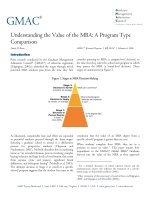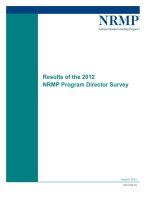The rebirth of the russian space program
Bạn đang xem bản rút gọn của tài liệu. Xem và tải ngay bản đầy đủ của tài liệu tại đây (22.46 MB, 375 trang )
The Rebirth of the Russian Space Program
50 Years After Sputnik, New Frontiers
Brian Harvey
The Rebirth of the
Russian Space Program
50 Years After Sputnik, New Frontiers
J^K.
<£J S p r i n g e r
Published in association with
Praxis Publishing
Chichester, UK
s~ y?
PRAXIS
Mr Brian Harvey
Terenure
Dublin 6W
Ireland
SPRINGER-PRAXIS BOOKS IN SPACE EXPLORATION
SUBJECT ADVISORY EDITOR: John Mason, M.Sc, B.Sc, Ph.D.
ISBN 978-0-387-71354-0 Springer Berlin Heidelberg New York
Springer is part of Springer-Science + Business Media (springer.com)
Library of Congress Control Number: 2007922812
Apart from any fair dealing for the purposes of research or private study, or criticism
or review, as permitted under the Copyright, Designs and Patents Act 1988, this
publication may only be reproduced, stored or transmitted, in any form or by any
means, with the prior permission in writing of the publishers, or in the case of
reprographic reproduction in accordance with the terms of licences issued by the
Copyright Licensing Agency. Enquiries concerning reproduction outside those terms
should be sent to the publishers.
© Praxis Publishing Ltd, Chichester, UK, 2007
Printed in Germany
The use of general descriptive names, registered names, trademarks, etc. in this
publication does not imply, even in the absence of a specific statement, that such
names are exempt from the relevant protective laws and regulations and therefore free
for general use.
Cover design: Jim Wilkie
Project management: Originator Publishing Services Ltd, Gt Yarmouth, Norfolk, UK
Printed on acid-free paper
Contents
Author's preface
ix
Acknowledgments
xi
About the book
xii
List of figures
xiii
List of maps
xix
List of tables
xxi
List of abbreviations and acronyms
xxiii
1
Almost the end
The admiration of the world
The collapse
Back on Mir: the long recovery
Almost the end: conclusions
1
5
7
11
16
2
Building the International Space Station
Origins of ISS
Paving the way for ISS: the last phases of Mir
Winding Mir down: "grief in our hearts"
The mark of Cassandra
Building the ISS
Waiting for Mir 2
Delay, delay and delay
Zvezda, 12th July 2000
Soyuz as lifeboat
Space station routine
17
17
19
25
29
35
37
39
40
43
46
vi
Contents
Space station depends on Russia
Completing the space station
Building the International Space Station: conclusions
References
57
67
74
75
3
Scientific and applications programs
Comsats: the Soviet inheritance
Comsats: the new generation
Weather satellites
Earth resources: Resurs DK, Sich M, Monitor
Materials-processing: Foton
Science: Koronas, Spektr
Small satellites
The unmanned program: conclusions
References
77
77
83
87
89
94
96
100
101
103
4
Military programs
Photo-reconnaissance
Close-look: Yantar 4K2 Kobalt
Mapping: Yantar 1KFT Kometa
Instant intelligence: Yantar 4KS2 Neman
Orlets and the rivers: Don and Yenisey
Space telescope: Araks
Electronic intelligence: Tselina
Maritime electronic intelligence: US P Legenda
Military communications: Strela, Gonetz, Potok
Navigation satellites: Parus, Nadezhda
Navigation: GLONASS
Military early warning system: Oko, Prognoz
The military space program: conclusions
References
105
106
109
110
Ill
112
114
116
118
121
124
127
132
136
138
5
Launchers and engines
Old reliable
New upper stages: Ikar, Fregat
Rus program
Cosmos 3M
Proton and Proton M
Proton M
Tsyklon
Zenit
Ukrainian rockets to the Pacific: Zenit 3SL, the Sea Launch
Rockot
Strela rocket
START
139
139
142
144
151
155
160
164
167
170
175
179
180
Contents vii
Dnepr
Volna, Shtil and relatives
New rocket: Angara
Russian rocket engines
GDL/Energomash: the most powerful rockets in the world
RD-180 powers the Atlas
Kosberg bureau/KBKhA in Voronezh
Isayev bureau/KhimMash
And from history, Kuznetsov's NK-33
Future launch vehicle and engine programs: Ural, Barzugin
Reliability
Conclusions: rockets and rocket engines
References
182
185
187
192
193
196
199
200
201
201
203
205
205
6
Launch sites
Baikonour
Plesetsk
Svobodny-Blagoveshensk
Dombarovska/Yasny
Soyuz a Kourou, French Guyana
Kapustin Yar: the Volgograd station
Alcantara
Recovery zones
De-orbit zones
Other ground facilities
Star Town, TsPK
Mission control Korolev: TsUP
Military mission control
Tracking and control
Cosmodromes and ground facilities: conclusions
References
207
208
221
227
229
229
234
235
237
244
246
246
254
257
257
262
263
7
The design bureaus
Energiya—premier design bureau
Chelomei's bureau and derivatives
NPO Lavochkin
NPO Yuzhnoye: missile lines "like sausages"
NPO PM, builder of comsats
KB Arsenal: the oldest design bureau
TsSKB Samara: continuous production from 1957
NPO Polyot
Organization of the space program
New space agency
Russia's space budget
From commercialization to space tourism
265
266
269
270
273
276
277
277
279
279
281
283
285
viii
8
Contents
Participation in the global commercial space community
Cooperation: rogue states
Cooperation: China
Cooperation: India
Organization: conclusions
References
293
302
306
310
312
313
Resurgent—the new projects
The federal space plan
Replacing the Soyuz: Kliper
Return to the moon: Luna Glob
Return to Mars: Phobos Grunt
Mars 500: no girls please, we're going to Mars
Final remarks
References
315
317
318
325
326
330
334
335
Appendix: Launchings 2000-06
337
Index
345
Author's preface
The rebirth of the Russian space program marks an important event: 50 years since the
first Sputnik was launched on 4th October 1957. At that time, few could have
imagined the dramatic events that lay head. The Soviet Union achieved all the great
firsts in cosmonautics—the first satellite in orbit, the first animal in orbit, the first
laboratory in orbit, the first probe to the Moon, the first probe to photograph its far
side, the first soft landing on the moon, the first man in space, the first woman in space,
the first spacewalk. Except one, the first human landing on the Moon. In 1964, the
Soviet Union decided to contest the decision of the United States to put the first
person on the Moon. The Soviet Union engaged in that race far too late, with divided
organization, and made a gallant but doomed challenge to Apollo.
Undaunted, the Soviet Union rebuilt its space program around orbiting stations,
building the first one, Salyut, and then the first permanent home in space, Mir. The
Soviet Union still achieved many more firsts: the first lunar rover, the first soft landing
on Venus, the first soft landing on Mars, the first recovery of samples from the Moon
by automatic spacecraft.
The original book in this series Race into space—a history of the Soviet space
programme (1988) was written during the heyday of the Soviet space program, when
the Soviet Union was launching over a hundred satellites a year and had a vast
program for the manned and unmanned exploration of space and its application
for practical benefits on Earth. The second book in the series, The new Russian space
program (1995) was compiled during the shock adjustment of the former Soviet space
program to the strained economic realities of life in the Russian Federation. The new
Russian space program took advantage of all the new information that had come to
light about Soviet history: thanks to the policy of openness (glasnost) begun by the last
president of the Soviet Union, Mikhail Gorbachev, we were now at last able to learn
about what had really taken place during the time of the Soviet period, as secrets
emerged into the light of day. The third book of this series, Russia in space—the failed
frontier? (2001) looked at the Russian space program in the period from 1992, when
x Author's preface
the Russian Federation came into existence. The title of course posed a question: Had
the Russian romance with cosmonautics run its course and "failed"? This book
chronicled the decline and difficulties of the 1990s, but also showed how the program
had adapted, survived and, sometimes grimly, held on.
Now, the fourth book in the series, The rebirth of the Russian space program looks
at the Russian space program at a convenient marking point, fifty years after Sputnik.
It chronicles developments since the turn of the century, takes a look at the Russian
program as it is now and looks toward the future. This account focuses on the years
2000 to 2006. Readers who wish to study the earlier history should return to Race into
space (for the Soviet period), The new Russian space programme (for the transition)
and Russia in space—the failed frontier? (for the 1990s). By way of definitions, this
book covers primarily the Russian Federation—but it does take in those parts of the
Ukrainian space program rooted in the old Soviet program.
The rebirth of the Russian space program coincides not only with Sputnik but with
the announcement by the government of the federation of a space plan to last to 2015,
an attempt to reinstitute goal-orientated planning in the program. If one looks at the
number of launches per year, Russia remains the leading spacefaring nation in the
world. At the same time, it is obvious that the Russian Federation's space program has
none of the ambition of the American space program, which has now sent extraordinary missions to all the corners of the solar system and plans to return astronauts
to the Moon and send them onward to Mars. Unlike the 1960s and 1980s, present-day
Russia has neither the capacity nor the will to challenge American leadership of space
exploration (the Chinese probably do, but that is another story). At the same time,
Russia will remain one of the world's space superpowers, a builder of space stations, a
formidable contributor to the world space industry and science. As this book shows,
the Russian space program is full of activity and life. Fifty years after Sputnik, the
dream lives on.
Brian Harvey
Dublin, Ireland, 2007
Acknowledgments
The author wishes to thank all those who contributed to this book through the
provision of ideas, information, comments, illustrations and photographs. In particular, he would like to thank: Rex Hall, Phil Clark, Bart Hendrickx and of course
Clive Horwood, the publisher, for his support and encouragement.
Photographs in the book come from the author's collection and from illustrations
published in the previous three editions of the book. He renews his thanks to those
who contributed. For this edition, he wishes to especially thank:
•
•
•
•
•
•
•
•
V.K. Chvanov in Energomash, for illustrations of rockets and engines;
Roman Turkenich in NPO PM Krasnoyarsk, for illustrations of the applications
satellites built by NPO PM;
V.M. Vershigorov in TsSKB Progress for images of the R-7 rocket and variants,
Resurs and the work of TsSKB;
Bert Vis, for his photographs of the US KMO;
Nicolas Pillet, for his images of Kliper;
Dominic Plelan, for his photograph of the botchka;
Peter Freeborn, Eurockot, for images of Rockot and Plesetsk Cosmodrome; and
NASA for images of the missions to the International Space Station.
Brian Harvey
Dublin, Ireland, 2007
About the book
First published as Race into space—a history of the Soviet space programme, Ellis
Horwood, 1988
Re-published as From competition to collaboration—the new Russian space programme, 2nd edition, by Wiley/Praxis, 1996
Re-published as Russia in space—the failed frontier? 3rd edition, published by
Springer/Praxis, 2001
Figures
Vasili Tsibliev
Michael Foale
Alexander Lazutkin
Mir
Buran launch
Checking rocket engines
Buran in its hangar
Sergei Krikalev
Visiting mission to Mir
Rocket engines, an export earner
The Mir service module
Dr. Valeri Poliakov
Shuttle and Mir
Progress approaching
Progress coming in
Shannon Lucid exercising on Mir
Soyuz and its docking system
Sergei Avdeev
Soyuz in orbit
Jean-Pierre Hagnere
Progress M prepared for launch
Alexander Kaleri
Dr Valeri Poliakov at Mir window, saying goodbye to departing astronauts
Russian space garden
FGB Zarya
Eventually Zarya was shipped and launched
Zvezda and Zarya together, at last
Preparing a Progress M
Yuri Usachov
Soyuz landing
2
3
4
5
7
10
11
12
14
15
18
20
21
22
23
23
24
26
27
28
29
30
34
35
36
37
41
42
44
45
xiv
Figures
The new Soyuz TMA
Progress diagram
Ready
Ignition
Liftoff
Climbing
Afterwards
Science Officer Peggy Whitson in Russian Sokol spacesuit
The Pirs module
Pirs arriving
Salizhan Sharipov spacewalking
Orlan spacesuit
Orlan spacesuit rear view
Orlan spacesuit side view
Salizhan Sharipov with TekH nanosatellite
Jettisoned spacesuit
Sergei Krikalev with Progress docking system
Cosmonauts set out for ISS
Gennadiy Padalka prepares for spacewalk
Valeri Tokarev exercising
Soyuz FG rocket climbing to ISS
Yuri Malenchenko with plasma crystal experiment
Urine removal system on ISS
Sergei Krikalev with Elektron system
Soyuz coming in
Soyuz—final stage of docking
Diagram of Soyuz
Ekran
Ekran M in preparation
New Luch
Ekspress A-4
Ekspress AK series
Ekspress AT series
Instruments for scanning the oceans
Early Resurs series
Resurs DK
Resurs DK in preparation
Okean
Foton
Bion
Koronas launcher, the Tsyklon
Launcher of small satellites, Cosmos 3M at Plesetsk
Zenit civilian derivative, the Resurs
Yantar civilian derivative, Resurs DK
Samara on the Volga
Zenit 2, launcher of Tselina
USP
Tsyklon, launcher of US P
Gonetz
46
47
48
48
49
49
49
51
51
52
53
54
55
56
57
58
59
59
60
62
63
66
67
68
69
69
70
80
81
82
83
84
85
88
90
91
92
93
95
97
98
100
107
108
113
117
119
120
123
Figures
Gonetz D-1M
COSPAS SARSAT
GLONASS in preparation
GLONASS M
GLONASS K
US KMO system
US KMO system, another view
R-7 evolution
Molniya M cutaway
Soyuz FG cutaway
Soyuz 2 first launch from Plesetsk
First Soyuz 2 operational launch—Metop
Soyuz 2 cutaway
Cosmos 3M production line
RD-216 engine
Cosmos 3M interconnector
Proton
Proton's RD-253 engine
Proton taking off
Proton evolution
Proton M
Briz
Tsyklon in factory
Tsyklon launch
Zenit 2 launch
RD-120 engine
Zenit 3SL
RD-171 engine
Odyssey platform
Sea Launch system
Rockot and tower
Rockot launch out of Plesetsk
Rockot launch site sketch
Rockot being raised
Dnepr launch
Angara 1
Angara 4
Angara launch site sketch
RD-191 engine
Valentin Glushko
RD-108
Energomash headquarters
Boris Katorgin
RD-180 engine
RD-180 on Atlas V
Plazma spacecraft (Cosmos 1818, 1867)
Diesel pulling rocket to the pad
Gagarinsky Start
Soyuz on the way to the pad on a misty morning
xv
123
126
128
130
131
134
135
141
142
145
145
146
148
152
153
153
155
156
157
159
161
162
165
166
167
168
170
172
173
174
176
177
179
180
183
188
189
190
191
193
194
195
196
197
198
201
209
210
211
xvi
Figures
Proton in assembly
Proton launch
Buran at the pad
Buran after landing
Baikonour in winter
Landing in the steppe
Baikonour, the former city of Leninsk
Disused pads at Baikonour
Plesetsk
Mirny
Cosmos 3M at Plesetsk
Satellite arrives at Plesetsk
Integration at Plesetsk (1) (2) (3)
First launch from Dombarovska, 2006
Kourou—Soyuz jungle take-off
Kourou—Soyuz readied for launch
Kourou—clearing the jungle
Tsyklon 4
Helicopters fly out
Helicopter near cabin
Landing engines ignite
Recovery of Yuri Malenchenko and Ed Lu
Flight back to Moscow
Foton landing in snow
Entry to Star Town in winter
Centrifuge in Star Town
Snowy Star Town
Soyuz training simulator in Star Town
TsUP
Large tracking dish
Tracking dishes in snow
Tracking ship Cosmonaut Yuri Gagarin
Early group of Soviet space designers
Sergei Korolev
Nikolai Sevastianov
Vladimir Chelomei
Georgi Babakin
Mikhail Yangel
Ukrainian small satellite
Ekspress AM-2, built by NPO PM
Progress rocket factory, Samara
Fitting shroud to Soyuz
Polyot, builder of the Cosmos 3M
Yuri Koptev
Cooperation with Europe—Foton
Space adventurer Greg Olsen returns
Anousheh Ansari preparing for mission with Michael
Mikhail Tyurin
Winter training
212
213
213
214
216
217
218
220
221
223
224
224
226
229
231
232
233
236
240
241
242
243
243
245
246
247
248
250
256
259
260
261
266
268
269
270
271
273
274
276
278
279
280
282
286
288
Lopez Alegria
and
290
292
Figures
Claudie Hagnere
Genesis, launched for Bigelow Aerospace
Microsatellites prepared for launch, Plesetsk
Making satellites—the shop floor
SAR Lupe
South Korea's Kompsat
The Shenzhou
The Soyuz spacecraft
KVD engine
Kliper
Nikolai Bryukhanov
Kliper's wings
Kliper's nose
Kliper on Onega launcher
Kliper docking system
Phobos, target of Phobos Grunt
Mars sample return
The bochka
xvii
293
295
300
301
303
306
308
309
311
319
320
320
321
323
324
327
329
331
Maps
Baikonour
Kapustin Yar
Plesetsk
Recovery zones, including Dombarovska
Soyuz a Kourou
208
234
222
238
230
Tables
2.1
3.1
4.1
4.2
5.1
5.2
5.3
5.4
6.1
6.2
7.1
7.2
7.3
7.4
Selection of Russian science experiments, International Space Station
Scientific and applications launches, 2000
Soviet/Russian photo-reconnaissance satellites
Russian military launches, 2000-6 in Cosmos series
The Russian rocket fleet
Versions of the Angara
Engines in the Russian rocket fleet
Reliability of Russian rockets by rocket
Launches by active cosmodromes, 2000-6
Russian cosmonaut squad, 2007
Main design bureaus and agencies in the Russian space program
World space budgets, 2006
Russian federal space budgets, 2001-6
World launch rates, 2000-6
65
102
106
137
140
190
192
204
237
252
267
283
284
312
Abbreviations and acronyms
3SL
CADB
CIS
CNES
comsat
COROT
COSPAR
COSPAS-SARSAT
CSTS
DELTA
DK
DMC
DMS-R
DS
DSP
elint
ELS
EOB
EORSAT
ESA
EVA
FG
FGB
FLPP
FLTP
GDL
GFZ
Three-stage Sea Launch (Zenit)
Chemical Automatics Design Bureau
Commonwealth of Independent States
Centre National d'Etudes Spatiales
communications satellite
COnvection, Rotation and planetary Transits
COmmittee on SPace Research
Search and Rescue Satellite System
Crew Space Transportation System
Dutch Expedition for Life, Technology and Atmospheric
(research program)
Dmitri Kozlov (satellite)
Disaster Monitoring Constellation
Data Management System
Dnepropetrovsky Sputnik
Defence Support Program
electronic intelligence
Ensemble de Lancement Soyuz
Electronic Order of Battle
Elint Ocean Reconnaissance SATellite
European Space Agency
Extra Vehicular Activity
Forsunochnaya Golovka (Fuel Injector)
Funkstionalii Gruzovoi Blok (Functional Cargo Block)
Future Launcher Preparatory Program
Future Launchers Technology Program
Gas Dynamics Laboratory
Geoforschungszeutrum (Geological Research Centre)
xxiv Abbreviations and acronyms
GLONASS
GPS
GRACE
GRU
GSLV
HIV
IAF
ICM
IKI
ILS
IM
IMBP
INDEX
INMARSAT
IP
IRDT
ISS
JPL
KB
KBKhA
KH
KOMPASS
Koronas
KTOK
MARSPOST
metsat
MIK
MOM
MPLM
MSNBC
NASA
NEM
Nil
NIP
NITsPlaneta
NPO
NSAU
OICETS
Globalnaya Navigatsionnaya Sputnikovaya Sistema
Global Positioning System
Gravity Recovery And Climate Experiment
Glavnoye Razvedyvatelnoye Upravleniye (main military
intelligence directorate)
GeoSynchronous Launch Vehicle
Human Immunodeficiency Virus
International Astronautical Federation
Interim Control Module
Institute for Space Research
International Launch Services
Issledovatl Modul
Institute for Medical and Biological Problems
INnovative technology Demonstration Experimental
(satellite)
International Mobile Satellite Organization
Instrument Point
Inflatable Reentry and Descent Technology
International Space Station
Jet Propulsion Laboratory
Design bureau
KB KhimAutomatiki (Chemical Automatics Design Bureau)
Key Hole (code name for American reconnaissance
satellites)
Complex orbital magneto plasma autonomous small satellite
Comprehensive Orbital Near Earth Observations of the
Active Sun
Ccomplex for simulators for spaceships
MARS Piloted Orbital STation
meteorological satellite
Integration and test building hall
Ministerstvo Obshchego Machinostroyeniye (Ministry of
General Machine Building)
Multi-Purpose Laboratory Module
Microsoft and NBC Universal News
National Aeronautics and Space Administration
Nauk Energiya Modul
Nauk Issledovatl Institut (scientific research institute)
Scientific instrument points
Scientific Research Center of Space Meteorology
Scientific and production association
National Space Agency of Ukraine
Optical Interorbit Communications Engineering Test
Satellite
Abbreviations and acronyms
OKB
OSETS
PAMELA
RAN
RD
RGRL
RKA
RKK
SKKP
SpKs
SRN
SSTL
START
T
TDRS
TM
TMA
TMK
TORU
TsAGI
TsDUC
TsPK
TsSKB
TsUP
TUB
UDM
UDMH
USA
USP
VDNK
VEGA
VHF
VMK
VPK
Opytnoye Konstruktorskoye Buro (experimental design
bureau)
Orbitalny Sborochno Eksploratsionny Tsentr (Orbital
Assembly and Operations Centre)
Payload for Anti Matter Exploration and Light nuclei
Astrophysics
Russian Academy of Sciences
Raketny Dvigatel (rocket motor)
Roentgen Gamma Rosita Lobster
Russian Space Agency
Rocket Cosmic Corporation
System for Monitoring Space
Spuskayemaya Kapsula
State security
Surrey Satellite Technology Ltd.
STrategic Arms Reduction Talks
Transport (Soyuz version)
Tracking and Data Relay System
Transport Modified (Soyuz version)
Transport Modified Anthropometric (Soyuz version)
Tizhuly Mezhplanetny Korabl (Heavy Interplanetary
Spaceship)
Tele Operatorny Rezhim Upravleniye (Television Remote
Control)
Central Institute for Aero Hydrodynamics
Center for Long-Range Space Communications
Yuri Gagarin Cosmonaut Training Center
Tsentralnoye Spetsializorov annoy e Konstruktorskoye Buro
(Central Specialized Design Bureau)
Tsentr Upravleniye Polyotami
Technical University of Berlin
Universal Docking Module
Unsymetrical Dimethyl Methyl Hydrazine
Upravleniye Sputnik (controlled sputnik, "active")
Upravleniye Sputnik (controlled sputnik, "passive')
Exhibition of Economic & Scientific Achievements
Venus Halley
Very High Frequency
Recoverable Maneuverable Capsules
Commission on Military Industrial Issues 280
xxv
1
Almost the end
The 25th June 1997 was a really, really bad day in the Russian space program. It is
not too much to say that it all nearly came to an end that one day.
On board the Mir space station, the flagship project of the Soviet and Russian
space fleet, it started as a routine day. Mir was in its twelfth year circling the Earth.
Crewing the station were two cosmonauts, Vasili Tsibliev and Alexander Lazutkin, as
well as an American visitor, British-born Michael Foale. Tsibliev and Lazutkin had
come on board in March, Foale the previous month. They had made Mir their home
and there they lived, ate, slept, watched the Earth, exercised to combat weightlessness
and carried out the many experiments for which the orbital station had been built.
Mir was a huge complex, more than 100 tonnes in weight, comprising a base block
(Mir) modules (Kvant, Kvant 2, Krystall, Spektr, Priroda), manned spacecraft
(Soyuz), unmanned freighters called Progress and beams and girders. There was a
central node where modules docked, control panels, laboratories, gardens, exercise
machines and sleeping berths. Air and electricity cables snaked around the walls and
through the tunnels. Mir was made homely by posters on the walls, a video library,
even a bookshelf.
The principal task of the day for Vasili Tsibliev was to guide in to Mir's docking
port a robot spacecraft, Progress M-34, using a remote controller called TORU.
Normally, unmanned Progress spacecraft came in using an automated Ukrainian
system called Kurs, but since the break-up of the Soviet Union the Ukrainians
charged a huge amount for Kurs docking systems, so the Russians were trying
something cheaper. The TORU was a small joystick, very much like a controller
used by a child on a computer game or play station. In front of him was a television
picture, beaming him the image of Mir from Progress as it closed in, along with
display data and grids superimposed on the screen. Using the TORU controller, he
would send radio commands to Progress to fire its thrusters to move faster, slower, up
2
The Rebirth of the Russian Space Program
or down, left or right. TORU was a simple, effective system, costing a hundredth the
price of the old Kurs.
The TORU had not been used before and Vasili Tsibliev, the space station
commander, was apprehensive, but it was no more challenging than hundreds of
similar tasks that he had undertaken while a cosmonaut. That was what he was
trained for. The previous day he had commanded the seven-tonne Progress M-34
freighter to separate from the orbital station and let it drift away for a couple of
kilometers. Now, he sent the signal for it to come back, guided in by the TORU.
What seems to have happened was this. Tsibliev commanded the freighter to
come in. He asked his colleague Alexander Lazutkin to position himself near one of
the windows to help him spot the arriving Progress. On the television set, it was
extraordinarily difficult for the Progress television to pick out Mir from a distance
against the speckled clouds of Earth underneath. Progress seemed to come in too
slowly. So, Tsibliev fired its thrusters to make it come in faster. Tsibliev and Lazutkin
used a set of squares on the screen to measure the distance (a square on the grid meant
it was 5 km out). Using a combination of the grid, a stopwatch and the television
camera, Tsibliev steered Progress in. When it was 1 km out, or so he thought, Tsibliev
applied a standard braking maneuver, in order to slow Progress to walking pace for
the final approach. All the time, he had Lazutkin watching out. On the screen, Mir
was much bigger now, filling four grids on the square. This time, Tsibliev was alarmed
at its rapid rate of approach. He fired the thrusters repeatedly to slow the freighter,
but to no avail. He and Lazutkin dashed from one window to the other, trying to spot
Progress and they enlisted the visiting astronaut Michael Foale in the effort. According to the plan, Progress should now have been 400 m out.
But it was too late. Lazutkin at last spotted the Progress, not at the 400 m on the
worksheet but at 150 m and closing rapidly. "It's here already!" yelled Lazutkin.
Vasili Tsibliev
Almost the end 3
Michael Foale
Progress careered into one of the laboratory modules at some speed, crumpled its
solar panels and drifted off to the side. Next thing, the astronauts felt a pop in their
ears: the pressure in the station had begun to drop. The station had been hit and was
punctured. Air was hissing out of the space station. The master alarm at once rang
out. The space station's manual stated that a pressure loss would empty air out of the
station in 18min: they would have to either evacuate the station within that time, or
seal the leak or they would be dead. Tsibliev yelled to Foale in Russian: "Va korabl!"
Foale understood Russian, but in English this meant: get into the attached Soyuz
spaceship to return to Earth!
Foale pushed himself quickly down the tunnel, into the node, into Soyuz at the
far end. Once there, he removed the hoses and cables going from the node into Soyuz,
so as to prepare it for emergency descent. Once he got there, he realized that his
colleagues had no immediate plans to join him in a fast plunge back to Earth: they
were trying to save the station first. You did not just abandon the pride of the Russian
space fleet without a fight.
Michael Foale was soon to realize that it was the Spektr laboratory that had
taken the hit. Spektr was, after all, his module, where he slept and carried out his
experiments. In theory, it was simple enough to close the hatch between Spektr and
the node, but the hatchway was full of cables and ducts. He at once rejoined his
colleagues. Lazutkin and Foale used a knife to cut the cables, sparks flying and tried
to close the hatch between the node and the module. It would not close—because the
escaping air was pulling it outward. However, the two men found a hatch cover on
their side which they jammed in its place from the node side, the escaping air sealing
it in. The leak was now on the other side of the hatch and they were saved. The job
took 14min and the air stopped venting at once. Pressure had fallen from 760 mm to
693 mm.









